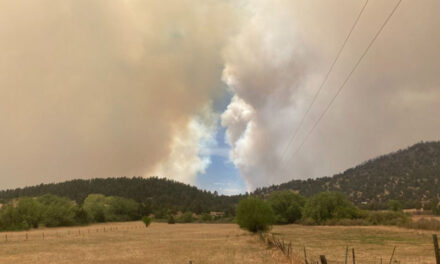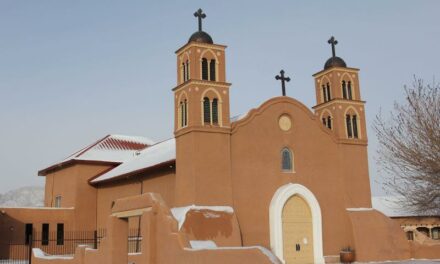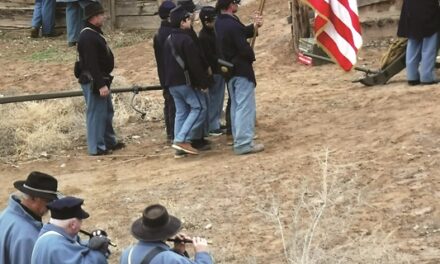With two forest fires southwest of Socorro only partially contained – the Bear Trap Fire at 28 percent and the Black Fire at 14 percent – smoke continues to be an issue for smoke-sensitive individuals in the areas of Socorro, San Antonio, Magdalena, Alamo, Datil, and Winston, as well as parts of Bernalillo, Valencia, and eastern Cibola Counties. Health officials encourage those with respiratory problems or heart disease to take precautionary measures by staying indoors during smoky days. According to the New Mexico Department of Health, even if you can’t smell the smoke or if it does not smell too bad that does not mean the air quality is safe. More information on air quality and protecting your health can be found at DOH’s Environmental Public Health Tracking website: nmtracking.org. An interactive smoke map at https://fire.airnow.gov/ allows you to zoom into your area to see the latest smoke conditions.
In the meantime, New Mexico Tech is providing dorm rooms for firefighters working the Bear Trap Fire to “rest and recharge.”
The university reports that 60 to 70 firefighters are spending their days sleeping in Torres Residential Hall after spending their nights fighting the fire.
David L. Greene, Ed.D., Tech’s Vice President for Student Life and Chief Diversity Officer, said in an NMT press release that with students moving out after the completion of the spring semester, the university is now able to provide needed space on its campus for the firefighters who have traveled from across the country to fight the Bear Trap Fire.
“The wildfires in New Mexico have impacted many of our students, faculty, staff, and their families,” he said. “We are happy to have the opportunity to provide space at this time.”
Brad Dischon, supervisor of a crew that traveled from Salem, Oregon, said in the release he doesn’t know how long firefighters will need to stay in New Mexico to fight the wildfire, but appreciates Tech’s contribution to the success of their efforts, helping his crew get the proper rest so they can be effective in their efforts fighting the wildfire on the night shift.
“It makes a big difference,” Dischon said, adding that the air-conditioned dorm rooms “help keep us fresh for when we’re on the line.”

Firefighters putting out hotspots and mopping up in the Bear Trap Campground area last weekend.
Photo courtesy of U.S. Forest Service, Cibola National Forest and Grasslands
As of Monday, the Bear Trap Fire has grown to over 28,000 acres and containment remains at 28 percent. On Tuesday, operations were formally transferred from the Southwest Area Type 2 Incident Management Team 4 to California Interagency Management Team 10 to develop strategies to fully contain the fire while protecting valuable resources in the area, including natural and cultural resources and infrastructure.
There are currently 642 personnel working the Bear Trap Fire.
This week, firefighters are diligently patrolling control lines on foot, in vehicles, and by air to ensure that fire does not threaten the containment perimeter. As crews continue to seek out and extinguish any remaining heat sources, less smoke is visible over the fire area each day. While firefighters on the ground are reinforcing control lines, a “firing boss” is leading aerial ignition operations from a helicopter. The firing boss coordinates ignitions inside the planned boundaries, slowly removing vegetation from the ridgetops down to the constructed lines staffed by the ground resources.
Resource Advisors are closely monitoring all ignitions and suppression repair activities to ensure that sensitive resources are protected.
According to a post on Cibola National Forest’s Facebook page, “Firefighters on the Bear Trap Fire were able to protect structures at the Bear Trap Campground by wrapping restrooms and signs in aluminized structure wrap. This fire-resistant material is similar to the fire shelters carried by firefighters for deployments in case of an emergency. The material reflects up to 95 percent of radiant heat and keeps embers from reaching the covered structures.”
Firefighters continue to patrol the campground area and extinguish any lingering pockets of heat. Smoldering forest fuels may continue to burn for days after flames are no longer visible. Firefighters will be ‘mopping up’ these areas by wetting or removing burning material within or close to the fire’s edge. Mop-up is hard, dirty, and tedious work that involves searching for smoke or hot spots in areas where fire has already passed through and then extinguishing them.”
The containment is predominately on the north perimeter as the main fire continues to slowly advance to the southeast.
Elsewhere in the region, 661 firefighters are battling the Black Fire, 31 miles west-northwest of Truth or Consequences in the Gila’s Black Range. The Black Fire, discovered May 13, has grown to 167,378 acres and has been deemed human-caused.
Evacuations for areas of Grant, Catron, and Sierra counties have been implemented and updated evacuation readiness statuses are found on nmfireinfo.com.




















